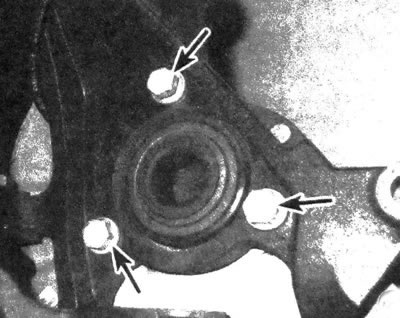Warning: Dust generated by pad wear is hazardous to health. Do not blow it off with compressed air or inhale dust. When servicing the brake system, it is recommended to wear a protective mask or respirator. Do not use benzine or solvents for cleaning. Use only a special cleaner to clean brake system components.
Note: the hub and bearing are a non-separable element, which, if one of the elements is damaged, is replaced entirely.
Removal
1. Loosen the front wheel nuts, lift the car and place it on vertical supports. Remove the wheel.
2. If performing the procedure on a four-wheel drive vehicle, remove the hub cap and, using a socket and long lever, unscrew the suitable shaft/hub nut (see chapter 8). Slide a large pry bar between the two wheel studs or a large screwdriver through the center of the caliper and disc cooling vanes to hold the hub steady while loosening the hub nut.
3. Remove the caliper and hang it on a piece of wire, then remove the caliper bracket (see chapter 9). Pull the disc off the hub.
4. Remove the wheel speed sensor from the hub (see illustration).

8.4. The wheel speed sensor is attached to the hub with a single screw, unscrew the screw and pull the sensor in a perpendicular direction (don't pry him)
5. Performing the procedure on the back side of the steering knuckle, unscrew the hub mounting bolts from it (see illustration). Remove the disk shield.

8.5. Remove the bolts securing the hub/bearing to the steering knuckle
6. Remove the hub from the steering knuckle. When performing the procedure on a four-wheel drive vehicle, it is necessary to pull the assembly off the drive shaft splines.
Caution: Do not allow the drive shaft to be pulled out, as this will cause the inner CV joint components to separate.
If you have difficulty disconnecting, install a two-arm puller on the hub flange and pull the drive shaft spline out of it. The hub should disengage from the steering knuckle, but if it does not, disengage it by lightly tapping it in various directions.
Installation
7. Clean the mating surfaces on the steering knuckle, bearing flange and knuckle groove.
8. Insert the hub together with the bearing into the steering knuckle. On an all-wheel drive model, it is also necessary to insert an axle shaft into it.
Note: Before installing the hub on a four-wheel drive vehicle, the axle splines must be lubricated with multi-purpose grease.
Install the disk shield and tighten its mounting bolts to the required torque.
9. Insert the wheel speed sensor into the hub hole and tighten the mounting bolt to the torque specified in Chapter 9 specifications.
10. Install the disc, bracket and caliper (see chapter 9).
11. On an all-wheel drive model, install the nut and tighten it to the torque given in Chapter 8 specifications. Insert a large screwdriver through the center of the caliper and disc cooling vanes to hold the hub steady while tightening the hub nut. Install the cap.
12. Install the wheel, lower the vehicle onto the supporting surface and tighten the wheel nuts to the torque specified in Chapter 1 specifications.
